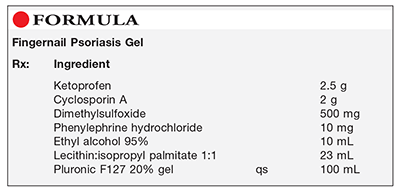US Pharm. 2014;39(10):52-53.

Method of Preparation: Calculate the quantity of each ingredient for the amount to be prepared. Accurately weigh/measure each ingredient. Combine the dimethylsulfoxide (DMSO), cyclosporin A, and ketoprofen with the alcohol; mix thoroughly. Add this to the lecithin:isopropyl palmitate solution; mix well. Dissolve the phenylephrine in a small amount of Pluronic F127 20% gel; add while mixing. Add sufficient Pluronic F127 20% gel to final volume; mix using a shear mixing method. Package and label.
Use: This preparation has been used to treat psoriatic conditions affecting the nails.
Packaging: Package in tight, light-resistant containers.
Labeling: Keep out of reach of children. Discard after ____ [time period].
Stability: Refer to the U.S. Pharmacopeia General Chapter <795>, Pharmaceutical Compounding—Nonsterile Preparations, to assign a beyond-use date for this preparation.1
Quality Control: Quality-control assessment can include theoretical weight compared with actual weight, specific gravity (SG), active drug assay, color, texture–surface, texture–spatula spread, appearance, feel, rheologic properties, and physical observations.2
Discussion: Ketoprofen (C16H14O3, MW 254.28) occurs as a white or almost white, odorless or almost odorless crystalline powder. It is practically insoluble in water, but is freely soluble in alcohol and ether. Its melting range is 92.0°C to 97.0°C. Ketoprofen has analgesic, anti-inflammatory, and antipyretic properties, and it is a cyclooxygenase inhibitor. It should be preserved in tight containers.1
Cyclosporin A (Ciclosporin, Neoral, Gengraf, C62H111N11O12, MW 1202.61) occurs as a white to almost white powder that is soluble in acetone and alcohol and practically insoluble in water. One use of this immunosuppressant is the treatment of recalcitrant plaque psoriasis in nonimmunocompromised adults unresponsive or intolerant to other systemic therapy.1
DMSO (sulfonylbismethane, methyl sulfoxide, (CH3)2SO, MW 78.14) occurs as a clear, colorless hygroscopic liquid with a bittersweet taste and faint to no odor. It boils at ~190°C and freezes at ~18.55°C. It is miscible with water, most aromatic and halogenated hydrocarbons, alcohols, ketones, esters, and most sulfur- and nitrogen-containing compounds. It has an SG of 1.095 to 1.101, a refractive index of 1.4755 to 1.4775, and a viscosity of 2.14 cP.3
Phenylephrine hydrochloride (Neo-Synephrine, C9H13NO2.HCl, MW 203.67) is a sympathomimetic amine that acts predominantly by a direct effect on alpha-adrenergic receptors. It occurs as white or practically white, odorless crystals with a bitter taste, and it is freely soluble in water and alcohol.1
Alcohol (ethyl alcohol, ethanol, grain alcohol, C2H5OH, MW 46.07) is a clear, colorless, mobile, volatile liquid with a slight, characteristic odor and a burning taste. Its SG is 0.812 to 0.816, and its boiling point is 78.15°C. It is miscible with chloroform, glycerin, and water.4
Lecithin (egg lecithin, soybean lecithin, vegetable lecithin) describes a complex mixture of acetone-insoluble phosphatides in combination with triglycerides, fatty acids, and carbohydrates. It is used as an emollient, emulsifying agent, and solubilizing agent in topicals, inhalation aerosols, parenterals, and oral suspensions. Color varies from brown to light yellow, depending upon whether it is bleached, and forms range from viscous semiliquids to powders. It is practically insoluble in water, polar solvents, and cold vegetable and animal oils; when mixed with water, it hydrates to form emulsions. It is soluble in aliphatic and aromatic hydrocarbons, mineral oil, and fatty acids.5
Isopropyl palmitate (C19H38O2, MW 298.51) is a colorless, mobile liquid that is used as an emollient, oleaginous vehicle, and solvent; it has a faint odor and good spreading characteristics. It is soluble in acetone, castor oil, cottonseed oil, alcohol, and mineral oil, and is insoluble in water, glycerin, and propylene glycol. It is resistant to oxidation and hydrolysis and does not become rancid. It should be stored in well-closed containers and protected from light.6
The poloxamers, a series of closely related block copolymers of ethylene oxide and propylene oxide, are used as emulsifying, solubilizing, and wetting agents. Poloxamers generally are white-colored, waxy, free-flowing granules or cast solids that are practically odorless and tasteless. Poloxamer 407 (Pluronic F127) is generally available in powdered form; it may be odorless or have a faint odor. It is freely soluble in water, alcohol, and isopropyl alcohol.
Note: When counseling patients concerning this preparation, it is advisable to explain its temperature-dependent viscosity. As the preparation is rubbed into the nail and warms up, it may become slightly more viscous and resistant to rubbing.7
REFERENCES
1. U.S. Pharmacopeia 37/National Formulary 32. Rockville, MD: U.S. Pharmacopeial Convention, Inc; 2014:403-453,1492,3469,4278.
2. Allen LV Jr. Standard operating procedure for performing physical quality assessment of ointments/creams/gels. IJPC. 1998;2:308-309.
3. DMSO product information. Mandeville, LA: Gaylord Chemical Corporation; 2014.
4. Fenton ME. Alcohol. In: Rowe RC, Sheskey PJ, Cook WG, Fenton ME, eds. Handbook of Pharmaceutical Excipients. 7th ed. Washington, DC: American Pharmaceutical Association; 2012:19-22.
5. Shah HC, Singh KK. Lecithin. In: Rowe RC, Sheskey PJ, Cook WG, Fenton ME, eds. Handbook of Pharmaceutical Excipients. 7th ed. Washington, DC: American Pharmaceutical Association; 2012:437-439.
6. Taylor AK. Isopropyl palmitate. In: Rowe RC, Sheskey PJ, Cook WG, Fenton ME, eds. Handbook of Pharmaceutical Excipients. 7th ed. Washington, DC: American Pharmaceutical Association; 2012:400-402.
7. Cable CG. Poloxamer. In: Rowe RC, Sheskey PJ, Cook WG, Fenton ME, eds. Handbook of Pharmaceutical Excipients. 7th ed. Washington, DC: American Pharmaceutical Association; 2012:573-577.
To comment on this article, contact rdavidson@uspharmacist.com.





